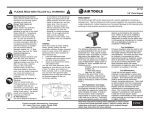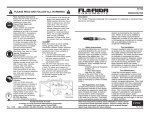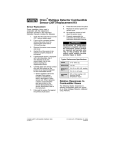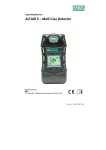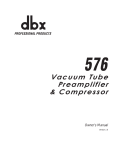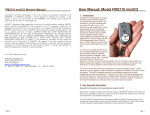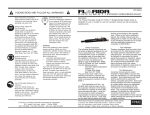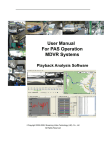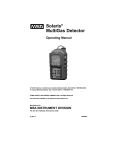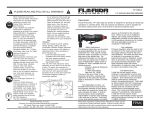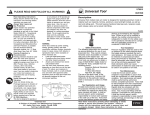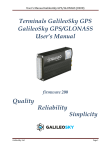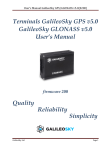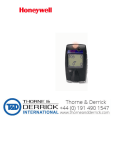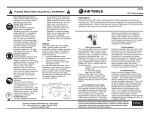Download WATCHMAN® MULTIGAS MONITOR
Transcript
WATCHMAN¨ MULTIGAS MONITOR FEATURES ■ ■ ■ ■ ■ ■ Continuously monitors combustible gases, oxygen, carbon monoxide and other toxic gases simultaneously; displays gas concentrations over large, easy-to-read digital readout. Rugged, portable aluminum case withstands harsh treatment. Wide range of measurement options, including peak exposure, short-term exposure and timeweighted average. Three push-buttons provide simple operation. Simplified calibration system eliminates need to open the instrument. Visible and audible alarms activate when gas concentrations exceed preset limits. 08-02-39 DESCRIPTION The Watchman Multigas Monitor is a durable, hand-held instrument used to detect and monitor combustible gases, oxygen and toxic gases in workplace atmospheres, especially in confined spaces such as manholes, storage tanks, tank cars, vaults, mines and sewers. Designed for rugged handling, the monitor incorporates the state-ofthe-art technology of the Passport¨ Personal Alarm in the strong, aluminum housing of the Portable Indicator and Alarm, Model 360. The Watchman Monitor also is easy to operate. The face of the instrument simultaneously displays the readings of all gases monitored. Users need not carry several instruments for monitoring multiple gases. Microprocessor-based, the instrument is menu-driven for ease of operation. The user can Òpage throughÓ various menu activities for calibration and display options. Watchman ÒkitsÓ that feature specialized accessories, such as optional remote sampling probes and battery chargers. When the unit is first activated, the Fresh Air Setup page automatically appears, allowing the user to adjust all gas readings to fresh air values with the push of a button. The monitor also provides readings on battery voltage and condition. A wide range of other display pages, including Peak Exposure, STEL (Short-Term Exposure Limit) and TWA (TimeWeighted Average), can be activated individually to provide customized operation. These measurements are displayed sequentially by pressing a button on the face of the instrument. Watchman sensors operate independently and monitor combustible gases, oxygen and up to three toxic gases, depending on user needs. Users can choose three gases from five available options, including carbon monoxide, hydrogen sulfide, sulfur dioxide, nitrogen dioxide and nitric oxide. If a sensor detects a dangerous condition, both visible and audible alarms will be activated. For more detailed information regarding the sensors, refer to Performance Specifications on Page 3. Designed for simple operation and training, the Watchman Monitor features only three buttons: POWER, to activate the unit; PAGE, which steps through the available display pages, and RESET, which turns off any alarm. To illuminate the display in dark work areas, a backlight comes on when any of these buttons are pressed. To conserve battery power, the backlight turns off automatically. Housed in a lightweight but rugged anti-static aluminum case, the Watchman Monitor weighs approximately 7.5 pounds and is equipped with a convenient carrying handle. The handle can be locked in any position through a 260¡ arc to provide a base when the instrument is used for semi-continuous sampling. A shoulder/waist harness is available as an optional accessory. Although primarily a portable instrument, the Watchman Monitor also can be used as a semi-continuous monitor in work areas where the need for one exists. In these cases, a full battery charge provides more than 10 hours of continuous monitoring. A built-in pump draws a sample from the immediate area Ñ or from confined spaces when used with MSA sampling lines. The Watchman Monitor is powered by an integral, rechargeable battery pack that provides 10-15 hours of sampling in a fully charged condition. Normal recharging is accomplished by plugging the charger into an appropriate outlet. Chargers are available for 8 to 24vdc and 120 or 240 volts, 50 or 60 Hz. All Watchman Monitor models are supplied with the userÕs choice of sensors and operating manuals. MSA also offers various packaged 2 Combustible Gas Monitoring The Watchman Monitor offers users a choice of two ways to display combustible gas: as a percentage of the LEL (Lower Explosive Limit) for general purpose use; or over a range of 0-5% methane, for gas utilities, water treatment plants, mines and other applications specific to methane. All configurations of the Watchman Multigas Monitor use MSAÕs exclusive Lockalarmª Circuit. The combustible gas sensing capability is ÒLEL-latching,Ó so that if the atmospheric condition reaches 100% LEL, the alarm will sound and cannot be silenced using the RESET button. The combustible display will show ÒOVER.Ó In this case, the alarm can only be reset by moving to a fresh air environment and turning the instrument off and back on again. This feature eliminates ambiguous readings inherent in catalytic combustible gas sensors. The latching feature provides an added level of protection in instances where combustible gas has displaced oxygen and/or exceeds the upper explosive limit (UEL). In these cases, the sensor might otherwise return to zero and the user might be misled into thinking the concentration had returned to a normal level. Instead, the alarm latches above 100% LEL. The pelement-type detector used for combustible gas monitoring is a low-power, catalytic filament-type sensor. The Watchman alarm sounds when combustible gas concentrations reach the alarm setpoint. Users can adjust the alarm setpoint, which is factory set at either 10% LEL or 1.0% methane, depending on the sensing method used. When the condition reaches the alarm setpoint, the red lights flash and the alarm horn sounds. The alarm can be silenced by pressing the RESET button, but will sound again if the atmospheric condition remains the same. Oxygen Monitoring The oxygen sensor indicates oxygen over a range of 0-25% by volume. The alarm is activated if there is too little or too much oxygen in the atmosphere. The alarm sounds when there is less than 19.5% oxygen by volume or more than 22% oxygen by volume. It can be easily calibrated using fresh air. Toxic Gas Monitoring Toxic gas sensors in the Watchman Monitor measure toxic vapors in partsper-million. For maximum versatility, users can adjust the instrument to alarm at a particular setpoint for each toxic gas. If the gas level goes above that setpoint, the alarm sounds, alarm lights flash and the concentration of gas flashes in the display. Alarms for gas exposure are latching. This means that if a user leaves the device in the work area and walks out, the alarm will continue to sound a warning even if the atmospheric condition returns to normal. This feature keeps users aware of the atmospheric condition of the work area. Once atmospheric conditions are not at alarm levels, the alarm can be silenced by pressing the “OVER” indicates that the instrument may be responding to a concentration above the UEL, and prompts users to move to a fresh air station. RESET button. Users can design their Watchman Monitor to detect any three of five available toxic gases. These gases are: carbon monoxide, hydrogen sulfide, sulfur dioxide, nitrogen dioxide and nitric oxide. WATCHMAN MULTIGAS MONITOR PERFORMANCE SPECIFICATIONS Gas Range Resolution Reproducibility Response Time Combustible 0-100% LEL 1% LEL ±3-50% LEL Reading ±5% LEL to 50-100% LEL 90% of final reading in 12 seconds (Normal Temperature Range)* Oxygen 0-25% O2 0.1% O2 0.3% O2 for 2-25% O2 90% of final reading in 15 seconds (Normal Temperature Range)* Carbon Monoxide 1000 ppm CO 1 ppm CO ±2 ppm CO or 10% of reading, whichever is greater 90% of final reading in 25 seconds (Normal Temperature Range)* Hydrogen Sulfide 50 ppm H2S 1 ppm H2S ±2ppm H2S or 10% of reading, whichever is greater 90% of final reading in 20 seconds (Normal Temperature Range)* Sulfur Dioxide 20 ppm SO2 1 ppm SO2 ±2 ppm SO2 or 10% of reading, whichever is greater 90% of final reading in 30 seconds (Normal Temperature Range)* Nitrogen Dioxide 20 ppm NO2 1 ppm NO2 ±2 ppm NO2 or 10% of reading, whichever is greater 90% of final reading in 35 seconds (Normal Temperature Range)* Nitric Oxide 100 ppm NO 1 ppm NO ±2 ppm NO or 10% of reading, whichever is greater 90% of final reading in 30 seconds (Normal Temperature Range)* *Temperature Range: Normal Temperature Range 0¡ to 40¡ C, 32¡ to 104¡ F Extended Temperature Range, when calibrated at temperature of use -18¡ to 40¡C, 0¡ to 104¡F 3 The FAS page asks the user whether the sensors should be calibrated to fresh air levels. The PAGE and RESET buttons become “soft keys” for YES and NO responses. OPERATION Instrument Self-Test The Watchman Multigas Monitor is activated by pressing the POWER switch on the front face of the instrument. The instrument will immediately perform a self-test. If a malfunction is detected through the self-test, ÒERRORÓ will appear and the instrument should not be used. Fresh Air Setup Option The Fresh Air Setup (FAS) automatically zeros all sensors in the unit and calibrates the oxygen readout to 20.8%. The FAS option is the first display to appear after the unit is turned on. With the push of a button, the sensors will automatically be set. For user protection, if a dangerous level of gas is present, the Watchman Monitor will ignore the FAS command and go into alarm. The FAS feature can be deactivated with an internal switch, if desired. Calibration Regardless of the monitoring method, the unit can be easily calibrated with the proper MSA calibration check kit and appropriate sample gas. (See Data Sheet 08-00-28 for more complete information on MSA calibration check kits.) Two levels of calibration are appropriate for the Watchman Multigas Monitor. The first is a simple check of the calibration response, and the second is calibration adjustment. To check response, the person performing this check simply applies calibration gas of a known concentration to the instrument. If the response is within allowable limits, the Watchman Monitor is ready for use. If adjustments are necessary, the calibration mode is entered by using the three buttons on the face of the Watchman Monitor. No tools are needed to enter the calibration mode. For proper calibration and adjustment, MSA offers Calibration Check Kits and Calibration Gas Cylinders or Ampoules. To set the readings to match the proper response, the PAGE and RESET buttons provide Ò+Ó and Ò-Ó functions, to either raise or lower the reading on the display. Throughout the calibration procedure, on-screen prompts guide the user through the process. Display Options After the Watchman Multigas Monitor has been turned on and (unless defeated) the FAS procedure has been completed, a standard display page 4 will be shown to indicate the level of each gas in the area. In addition to this display page, the instrument features pages that indicate battery condition, peak readings, STELs and TWAs. The pages can be sequentially shown by pressing the PAGE button. As a protective measure, the Watchman unit continues to monitor all gases, regardless of the display page being shown. Peak, STEL and TWA readings are optional displays, and can be shown if internal switches are set to perform these readings. Peak readings show the highest level of gas (or lowest, in the case of oxygen) that the Watchman Multigas Monitor records after initial activation or subsequent resetting. STEL readings show the average gas exposure during the previous 15minute period. TWA readings display the average gas exposure over time, based on 8 hours. The TWA average continues to accumulate whenever the Watchman Monitor is turned on. The TWA value will not be erased if the Watchman Monitor is inadvertently turned off. The user must deliberately reset the TWA reading or turn the Watchman Monitor Multigas Monitor off for more than 8 hours to reset the TWA. If the amount of gas detected by the Watchman Monitor is greater than either the STEL or TWA limit, the unit will go into an alarm mode. After viewing the Peak, TWA or STEL pages, the user simply presses the PAGE or POWER button to return to the standard display page. Tag Ñ This feature allows the user to ÒtagÓ data up to 10 characters in length for information gathered during a specific sampling session. For instance, the user can record a specific street address, or location within a plant, and ÒtagÓ it onto gas concentration data recorded during a sampling session. These tags can be changed and entered many times to record changes in location or activity during the day. These tags can later be downloaded to a personal computer. Alarms If a dangerous condition is detected by the Watchman Multigas Monitor, an alarm ÒflagÓ will appear in the display along with the gas concentration, two red lights flanking the face of the instrument will flash, and an electronic horn will sound. When the alarm sounds, users should evacuate the work area and/or follow work practices prescribed by their safety officer. After leaving the work area, or after the conditions causing the alarm have returned to non-alarm levels, the alarm may be silenced by pressing the RESET button. Remote Sampling Probes and lines of up to 50 feet in length may be used to test confined spaces or remote areas before entry. Time-delay Feature The POWER switch must be pressed and held down for more than five seconds to turn off the Watchman Multigas Monitor. This Òtime-delayÓ feature prevents users from accidentally turning the Watchman Monitor off while they are still working in a confined space. Battery Pack Functions During operation, the Watchman Multigas Monitor assesses battery voltage. When the instrument determines there are less than 30 minutes of remaining operation from the battery pack, ÒBATTÓ appears on the display, and the unit goes into the alarm mode. If the unit is reset by the user, the alarm will continue to sound every five minutes until the power is turned By attaching probes and lines to the Watchman Multigas Monitor, workers can test remote areas or confined spaces before entry. off or the battery condition reaches a very low level. When battery pack voltage drops to a level where the Watchman Monitor should not be used, the battery alarm will sound continuously and cannot be reset unless the unit is turned off. If the unit is left on, it will shut down automatically within approximately five minutes. The MSA Omega¨ Battery Charger will charge the Watchman Monitor. When fully charged, the standard battery pack operates the Watchman Multigas Monitor for 10 hours at 32¡ F and for more than 15 hours at room temperature. 5 SERVICE MSAÕs strategically located regional service centers are staffed with specialists who have the knowledge and equipment to provide testing, calibration, and maintenance for Watchman Multigas Monitors, using genuine MSA replacement parts. Product modification or repair by other than certified MSA personnel may void warranties and approvals. For the location of your nearest MSA Service Center, call tollfree 1-800-MSA-2222. these Assemble-to-Order (ATO) versions of the Watchman Monitor can be shipped the same day, providing the order is received by 9:00 a.m. EST. All Watchman Multigas Monitor Kits are supplied with a technical manual, userÕs manual, instruction card and service card, packaged in a convenient cardboard carrying case. Battery Charger Part No. 494716 Single-Unit Omega Charger, 110V; 50/60 Hz 495965 Single-Unit Omega Charger, 220V; 50/60 Hz 801759 Five-Unit Omega Charger, 110/220V; 50/60 Hz 710423 Single-Unit Omega Charger, Vehicular; 8-28 VOC The Watchman Multigas Monitor is capable of storing data and downloading it to a PC through the Data Docking Module. APPROVALS & STANDARDS The Watchman Multigas Monitor has been designed to meet intrinsic safety testing requirements in certain hazardous atmospheres. The Watchman Multigas Monitor has been approved by MET for use in Class I Division 1, Groups A,B,C and D; Class II Division 1, Groups E,F,G; and Class III hazardous locations. Watchman Multigas Monitor has also been approved by CSA for use in Class I, Division 1, Groups A, B, C and D locations. Other third party approvals are pending. Contact MSA at 1-800-MSA-2222 for approval status. Limitations: The Watchman Multigas Monitor detects gases and vapors in air only. It cannot measure combustible or toxic gases in reducing atmospheres, furnace stacks or environments with inert backgrounds because the combustible gas sensor requires oxygen to work. It cannot measure the presence of combustible airborne dusts such as grain or coal dust. The instrument is designed to be used only in atmospheres where the oxygen concentration is more than 10% oxygen by volume (an oxygen-deficient atmosphere) or less than 22% (an oxygen enriched atmosphere). Caution: Silicone, silicates and lead-containing compounds tend to desensitize the combustible gas sensor and can cause inaccurately low readings. If there is even a small chance that such materials are in the atmosphere being tested, calibration checks of the instrument should be made frequently. ORDERING INFORMATION A wide range of Watchman Monitor configurations are available to suit your needs. These variations and how to order them are described in the ÒAssemble-to-Order System and Price Information for the Watchman Multigas Monitor.Ó Your choice of sensors, chargers, sample lines, accessories, etc. which suit your specific needs can be ordered off of a menu. This menu is simple to follow and lets you immediately determine the price of the package you want. In most cases 6 Replacement Parts Part No. 478537 Combustible Gas Sensor 480566 Oxygen Sensor 636240 Carbon Monoxide Sensor with Gasket 636241 Hydrogen Sulfide Sensor with Gasket 807476 Sulfur Dioxide Sensor with Gasket 807477 Nitrogen Dioxide Sensor with Gasket 808350 Nitric Oxide Sensor with Gasket ACCESSORIES Data Docking Module The Watchman Multigas Monitor is capable of storing data and downloading it to a PC through the Data Docking Module. The data can be presented in ASCII text or in a Lotus 12-3* format. The Watchman Multigas Monitor stores data in one minute increments. These increments are an average of multiple readings taken in each minute. The capacity of data stored depends largely on the number of sensors the instrument has and the number of alarms and events the instrument experienced. For example, *Lotus and 1-2-3 are trademarks of Lotus Development Corporation for a four gas instrument, up to 12 hours of data and 100 events, such as alarms, power off, power on, etc., are stored. The time and data is recorded with each increment. One Data Docking Module can be used with any number of Watchman Multigas Monitors, facilitating the need for only one Data Docking Module at each location. It is powered by a 9-volt alkaline battery or the MSA Omega charger which is used to recharge the Watchman Multigas Monitor. The Data Docking Module is connected to a PC by a 9-pin serial communication port. User friendly, the software has many help screens which can be accessed at any time. Part No. 804679 Data Docking Module Kit. Includes the Data Docking Module, MSA Link Software and Instruction Manual Sampling Equipment Remote sampling equipment from MSA allows users to check the gas concentrations of confined spaces before entering the area. Water Stop sampling probes and lines of various lengths are available to meet a wide range of user needs. Sampling Accessories Part No. 11354 5-foot sampling line 11955 10-foot sampling line 11912 15-foot sampling line 11913 25-foot sampling line 11958 50-foot sampling line 486934 Probe, 20-inch, phenolic 11961 Probe, 3-foot, brass 73743 Probe , 3-foot, phenolic 11960 Probe, 4-foot solid brass with holes near handle 710459 Water trap system 711257 In-line filter 710445 Replacement filters, pkg of 5 Calibrating Equipment MSA calibrating equipment provides a convenient method to check the response time of the Watchman Multigas Monitor as it measures combustible gas, oxygen and toxic vapors. Calibration testing is conducted with known concentrations of pressurized gas to help ensure accurate readings. Calibration Equipment Part No. 478192 Calibration Gas: 60% LEL pentane simulant, 15% oxygen 478191 Calibration Gas: 60% LEL pentane simulant, 15% oxygen, 60 ppm carbon monoxide 804769 Calibration Gas: 60% LEL pentane simulant, 15% oxygen, 10 ppm hydrogen sulfide 804770 Calibration Gas: 60% LEL pentane simulant, 15% oxygen, 300 ppm carbon monoxide, 10 ppm hydrogen sulfide 467898 Calibration Gas: 10 ppm hydrogen sulfide 812144 Calibration Gas: 50 ppm nitric oxide 7 Calibration Equipment Part No. 808977 Calibration Gas: 10 ppm nitrogen dioxide 808978 Calibration Gas: 10 ppm sulfur dioxide 477150 Calibration Check Kit, Model RP, (less calibration gas) including: 467896 Regulator, 1.5 lpm 449401 Adapter hose (with sampling line connection) 710288 Gas Miserª Demand Regulator, 0-3.0 lpm Part No. 710474 Training Video Remote Alarms MSA Remote Alarms provide an additional audible alarm in noisy or confined space environments. When an alarm condition occurs, both the Remote Alarm and the Watchman Alarm will sound simultaneously to provide added protection. In high-noise environments, workers can use a Remote Alarm. If hearing protection must be worn, the Remote Alarm can be used to overcome the noise attenuation of the hearing protection. Or, if the Watchman Monitor is used in conjunction with remote sampling accessories, the Remote Alarm can be placed in a confined space while a ÒbuddyÓ or ÒattendantÓ remains outside with the monitor. Thus both will be warned if an alarm condition occurs. Part No. 800992 800991 800365 Be Sure Choose MSA. Note: This Bulletin contains only a general description of the products shown. While uses and performance capabilities are described, under no circumstances shall the products be used by untrained or unqualified personnel and not until the product instructions including any warnings or cautions provided have been thoroughly read and understood. Only they contain the complete and detailed information concerning the proper use and care of these products. 90-dB Remote Alarm 105-dB Remote Alarm 15 foot extension cable Offices and Representatives in principal cities worldwide. In U.S. call the Customer Service Center toll-free at 1-800-MSA-2222. To reach MSA International, call (412) 967-3354 or fax (412) 967-3451. Visit our web site at www.MSAnet.com Corporate Headquarters: P.O. Box 426, Pittsburgh, PA 15230 USA Data Sheet 08-02-39 ©MSA 1997 Printed in U.S.A. 9712(L)








